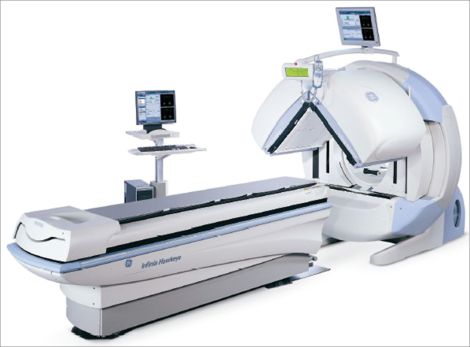A Parathyroid Scan is a radiological procedure performed in the Nuclear Medicine department to examine potentially overactive parathyroid glands. Parathyroid glands are small pea-sized glands that are typically located just above and just below the thyroid.
In some cases, parathyroid glands can grow ectopically (not in the normal place) in the upper chest (upper mediastinum). The parathyroid is involved in regulating Calcium levels in your bloodstream through the release of hormones (Parathyroid hormone). Your doctor may order a Parathyroid Scan if you have increased levels of parathyroid hormone in your blood.
Preparation
There is no required preparation for a parathyroid scan; Eat, drink, and take your medications as normal.
PLEASE INFORM YOUR DOCTOR OR THE TECHNOLOGIST IF YOU ARE, OR THINK YOU MIGHT BE, PREGNANT OR BREASTFEEDING.
Procedure
Check-in at the Diagnostic Imaging Department at the Sault Area Hospital for your appointment.
To perform a Parathyroid scan you will be given an injection containing a small amount of a radioactive tracer (Tc-99 Sestamibi). The injection goes into a vein similar to blood work and you shouldn’t feel anything from it. Once injected you will be asked to wait 10 minutes for the tracer to localize in your thyroid and parathyroid glands. After the 10 minute wait, you will be positioned under our camera and a 10-minute picture will be taken to show how the tracer is initially distributed throughout your thyroid and parathyroid.
Following the first picture, you will be asked to return to the nuclear medicine waiting room after sufficient time has elapsed to allow for the radioactive tracer to clear out of the thyroid. Typically it takes between 2 ½ to 4 hours for the injection to clear out of your thyroid leaving the radioactive injection mainly in the parathyroid. There are no other restrictions during this time.
For the delayed scan, you will be required to lie flat on the imaging bed for about 30 minutes while we take 2 sets of pictures of your thyroid area. The first picture will be the same as the initial picture and take about 10 min. Follow that picture we will take another set of images to create a 3-Dimensional image of the area.
The second picture will take about 20 min and is performed in 2 parts. For the first part of the second image, the camera will very slowly rotate around you taking pictures as it goes. This picture is known as a Single Photon Emission Computed Tomography (SPECT imaging). The second part will be a low dose CT scan that will be fused together with SPECT scan creating what is known as a SPECT/CT scan. The SPECT/CT scan will allow for the localization of any areas of interest.
Following your test, there are no restrictions and you will be able to drive as you normally would. If you are planning on going into the United States of America you will set off the radiation detectors for approximately 2-3 days. We can provide a letter explaining why you are setting off the detectors however you will still be stopped.
Once your scan is complete it will be examined by a radiologist and a report will be sent to the ordering doctor within a week. Follow up your test with the ordering physician or your family doctor.
The Injection
The amount of radioactive tracer injected for a parathyroid scan is small enough that there are no additional requirements or precautions to protect others from radiation exposure. The radiation exposure to you is a little more than a standard chest x-ray and less than half of that from a CT scan. Most of the injection will be cleared out of your body after 24 hours.
Allergic reactions to the material are extremely rare, and you should not feel anything or notice any changes from the material injected.
The Camera
For a parathyroid scan, we acquire the images using a gamma camera. A gamma camera is a type of radiation detector that is used to show us how the radioactive tracer is distributed throughout your thyroid area. Our cameras do not emit any radiation unless performing a SPECT/CT and are not a hazard to anyone in the vicinity while acquiring. Additionally, our cameras do not make any loud noises. The cameras we use have 2 detectors: one above you and one below you. Dual camera heads allow two views to be acquired at the same time, and for SPECT imaging to be acquired in half the time.

